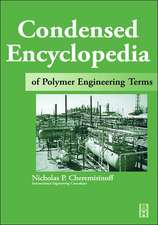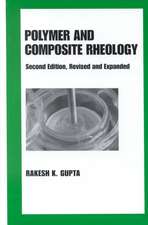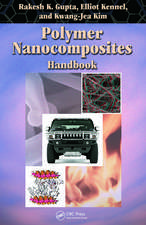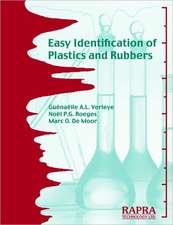Graphite, Graphene, and Their Polymer Nanocomposites
Editat de Prithu Mukhopadhyay, Rakesh K. Guptaen Limba Engleză Hardback – 30 oct 2012
The focus then moves to graphene and its unique features, and techniques for its characterization. The chapters cover advances in electrochemical exfoliation of graphite, as well as exfoliation routes to produce graphene and graphite nanoplatelets for polymer composites. They also explore commercial use of graphene-based materials, such as emerging clean energy and pulse laser applications, and use as nanofillers in epoxy-based composites. The authors provide an overview of nanofillers and address two methods for GPNC preparation as well as specialized properties of GPNC. With its multidisciplinary approach, this book provides a broader scientific and engineering perspective necessary for meaningful advancements to take place.
Preț: 1346.76 lei
Preț vechi: 1642.39 lei
-18% Nou
Puncte Express: 2020
Preț estimativ în valută:
257.70€ • 269.78$ • 213.23£
257.70€ • 269.78$ • 213.23£
Carte tipărită la comandă
Livrare economică 05-19 aprilie
Preluare comenzi: 021 569.72.76
Specificații
ISBN-13: 9781439827796
ISBN-10: 1439827796
Pagini: 632
Ilustrații: 311 b/w images, 47 tables and 29 equations
Dimensiuni: 156 x 234 x 38 mm
Greutate: 1.02 kg
Ediția:New.
Editura: CRC Press
Colecția CRC Press
ISBN-10: 1439827796
Pagini: 632
Ilustrații: 311 b/w images, 47 tables and 29 equations
Dimensiuni: 156 x 234 x 38 mm
Greutate: 1.02 kg
Ediția:New.
Editura: CRC Press
Colecția CRC Press
Public țintă
Universities and research laboratories in academia and industry involved in materials science and working with graphite, graphene, nanoparticles, polymers and nanocomposites.Cuprins
Graphite: Structure, Properties, and Applications. Electronic Transport in Graphene: Theory and Applications. Different Characterization Techniques to Evaluate Graphene and its Properties. Electrochemical Exfoliation: A Cost-Effective Approach to Produce Graphene Nanoplatelets in Bulk Quantities. Exfoliation of Graphite toward Graphene from Lab to Industry. Graphene-Based Materials for Clean Energy Applications. Electrochemistry of Graphene-Based Nanomaterials. Graphene–Polymer Composites for Pulse Lasers. Epoxy Nanocomposites: Graphene a Promising Filler. Nanoparticles and Polymer Nanocomposites. Polymer-Functionalized Graphene via Atom Transfer Radical Polymerization Route for Graphene-Based Polymer Nanocomposites. Synthesis and Properties of Graphene-Based Nanocomposites in a Biodegradable Polymer. Effect of Modified Graphene on Properties of Polypropylene Nanocomposites. Diffusion through Polymers Containing Platelike Nanomaterials. Using Functionalized Graphene Sheets to Restrain Chemically Driven Composite Aging. Graphene/Polymer Nanocomposites. Highly Filled Graphite-Polymer Composites: Synthesis, Processing, and Characterization.
Notă biografică
Prithu Mukhopadhyay is a scientist with IPEX Technologies, Inc. in Montreal, Canada. Since 1997, he has been engaged in R&D as well as manufacturing and quality management for injection molding and extrusion. He earned his master’s degree in organic chemistry and his Ph.D. in polymer chemistry from the Indian Institute of Technology, Kharagpur. Prithu is passionate about new plastics technologies, and he has been a member of the New Technology Committee of the Society of Plastics Engineers since 1998. He has chaired the committee in the past, and he has been active in developing New Technology Forums at the Annual Technical Conference of the Society since 2000. He is an expert on plastics piping materials, and he has published and spoken extensively on this and a variety of polymer topics. He is the founding editor of Plasticstrends, an educational website that was established in 2000.
Rakesh K. Gupta is the George B. and Carolyn A. Berry professor and department chairman of chemical engineering at West Virginia University where he has been teaching since 1992. He holds B. Tech. and Ph.D. degrees in chemical engineering from the Indian Institute of Technology, Kanpur, and the University of Delaware, respectively. His research focuses on polymer rheology, polymer processing, and polymer composites. He has published more than 100 journal papers, 65 conference papers, and 12 book chapters on these topics. He also holds three U.S. patents. He is the author of Polymer and Composite Rheology, the coauthor of Fundamentals of Polymer Engineering and the coeditor of Polymer Nanocomposites Handbook.
Rakesh K. Gupta is the George B. and Carolyn A. Berry professor and department chairman of chemical engineering at West Virginia University where he has been teaching since 1992. He holds B. Tech. and Ph.D. degrees in chemical engineering from the Indian Institute of Technology, Kanpur, and the University of Delaware, respectively. His research focuses on polymer rheology, polymer processing, and polymer composites. He has published more than 100 journal papers, 65 conference papers, and 12 book chapters on these topics. He also holds three U.S. patents. He is the author of Polymer and Composite Rheology, the coauthor of Fundamentals of Polymer Engineering and the coeditor of Polymer Nanocomposites Handbook.
Recenzii
“The book is very comprehensive … written by internationally known researchers. It covers fundamentally important aspects, starting from graphite, moving on to graphene, and then to their polymer nanocomposites. I find a nice balance between theoretical aspects and experimental studies. … The authors have done a great job in distilling their work for their respective chapters. This is a reference work that should find its place among its peers in a scientific library.”
—Dr. Vassilios Galiatsatos, Fellow SPE, Leibniz Institute of Polymer Research Dresden, Germany
“… relevant to real-world applications for graphene, graphene-like, and near graphene materials that are now reaching the marketplace. The [contents] follow a logical progression, from graphite-basics, to characterization of graphitic and graphene materials, lab and industrial synthesis, and include a wide range of applications-related chapters. Researchers, applications engineers, manufacturing chemists, polymer scientists, formulators, and other individuals involved in graphene materials will be enticed to read further.”
—Albert V. Tamashausky, Asbury Carbons Inc, New Jersey, USA
“Graphene and graphene-based materials are finding increasing applications in a variety of settings ranging from medical, biological, and energy related areas. Undoubtedly, it is one of the most promising materials of future. Therefore, the present handbook is timely and appropriate to provide a state of the art account spanning all aspects including production, characterisation and property-structure relationships … . Yet at the same time directing an interested reader to specialised research papers to dig deeper into specific aspects.
The editors have skillfully compiled virtually the complete spectrum of graphite, graphene, and their nanocomposites technology. … Each chapter has been written by a well-known individual possessing extensive firsthand experience combined with complete familiarity with the contemporary literature. This handbook has all the ingredients to become one of the most influential resources in this emerging field.”
—Dr. Raj Chhabra, Indian Institute of Technology (IIT) Kanpur, India
“Graphene is the new wonder material and a premium carbon product. Researchers are still in the initial stages of discovering all its properties and potential applications. Indeed, there is significant research on simply finding convenient ways to synthesize graphene in reasonable quantities. This book brings together key players from all over the world, and these researchers present the state of the art in this convenient and easy-to-read edited volume. This book is a rendering of both the science and technology of graphene and its utilization in polymer nanocomposites. It is extremely well done … . The research into graphene has just begun, and this book has the potential to act as the guide for those contemplating their own journey into this emerging area of materials science and engineering.”
—Dr. Henk Verhoogt, SABIC, Sittard, The Netherlands
—Dr. Vassilios Galiatsatos, Fellow SPE, Leibniz Institute of Polymer Research Dresden, Germany
“… relevant to real-world applications for graphene, graphene-like, and near graphene materials that are now reaching the marketplace. The [contents] follow a logical progression, from graphite-basics, to characterization of graphitic and graphene materials, lab and industrial synthesis, and include a wide range of applications-related chapters. Researchers, applications engineers, manufacturing chemists, polymer scientists, formulators, and other individuals involved in graphene materials will be enticed to read further.”
—Albert V. Tamashausky, Asbury Carbons Inc, New Jersey, USA
“Graphene and graphene-based materials are finding increasing applications in a variety of settings ranging from medical, biological, and energy related areas. Undoubtedly, it is one of the most promising materials of future. Therefore, the present handbook is timely and appropriate to provide a state of the art account spanning all aspects including production, characterisation and property-structure relationships … . Yet at the same time directing an interested reader to specialised research papers to dig deeper into specific aspects.
The editors have skillfully compiled virtually the complete spectrum of graphite, graphene, and their nanocomposites technology. … Each chapter has been written by a well-known individual possessing extensive firsthand experience combined with complete familiarity with the contemporary literature. This handbook has all the ingredients to become one of the most influential resources in this emerging field.”
—Dr. Raj Chhabra, Indian Institute of Technology (IIT) Kanpur, India
“Graphene is the new wonder material and a premium carbon product. Researchers are still in the initial stages of discovering all its properties and potential applications. Indeed, there is significant research on simply finding convenient ways to synthesize graphene in reasonable quantities. This book brings together key players from all over the world, and these researchers present the state of the art in this convenient and easy-to-read edited volume. This book is a rendering of both the science and technology of graphene and its utilization in polymer nanocomposites. It is extremely well done … . The research into graphene has just begun, and this book has the potential to act as the guide for those contemplating their own journey into this emerging area of materials science and engineering.”
—Dr. Henk Verhoogt, SABIC, Sittard, The Netherlands
Descriere
Perhaps the first of its kind, this book explores emerging research trends in graphene-based polymer nanocomposites, including the underlying physics and chemistry. Covering the entire spectrum of graphene-based materials topics, from synthesis to characterization to processing and practical applications, this state-of-the-art book provides the point of departure for future polymer-based nanocomposites research. The chapter authors, drawn from experts from around the globe, summarize their recent research and provide their perspectives for the future by drawing attention to the challenges that must be addressed before research results are fully integrated into the next generation of science and engineering applications.




















